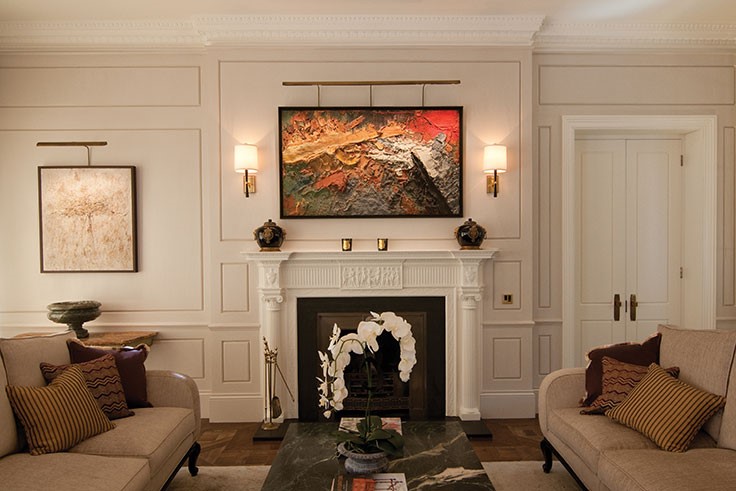Top 8 Tips for Lighting a Painting
Top 8 Tips for Lighting a Painting

"The purpose of art is washing the dust of daily life off our souls."
Haven't you often heard this in conversations about art? One friend resorts to this famous quotation by Pablo Picasso while defending his splurge on that very expensive piece of art that now hangs in the entrance of his house. As you gaze at the painting, you realize that something is missing. Picture Lights!
So, what really are these picture lights and why are they so important? Let's say you spent a big lump sum amount on buying a diamond ring. You're ready to flaunt it at a party, but the lighting is very dim, so your ring doesn't stand out. Although it's beautiful in itself, the effect is mitigated.
Now let's think about a painting that you bought. You hung it in your room, but something doesn't feel in place. You move around the furniture, try different walls and even choose new wallpaper for a more striking background. What you don't realize is the painting light isn't enough. The details don't speak out, and the painting hangs dry and dull, not being able to express itself.
A picture light is an art piece in itself. So, when you're thinking about buying that new painting to fill the unattractive whitewall in your office, you need to realize that it's a two-step process.
- Choosing the right painting
- Choosing the right lighting for paintings
So below are few tips and tricks for lighting for art. Your picture lights will definitely make that painting steal the entire spotlight in the room.
1. Avoid Natural Light

Most of us think that placing artwork near windows is a good idea. We think that sunlight will work as a natural picture light. This is not at all true!
When we place the painting in sunlight, it is in direct exposure to ultraviolet light and infrared. Both of these cause the painting to fade over time. So, if you're deciding near which window sill you should place that beautiful scenery you bought, here is some advice: DON'T!
2. Position and Intensity of the Light
Picture lights should be placed at a 30-degree angle. This is very essential if you want to avoid glare. Nobody wants to look into an antique painting and see a harsh light flashing across it!
You should follow the 5-degree rule for even better picture lighting. To avoid casting a shadow, add 5 degrees to the lighting. Subtract 5 degrees if you want to enhance the texture of the painting and make that oil paint pop or the acrylic shine.
Although this seems like a very small angle change while giving lighting for a picture, especially in case of larger frames, it can make all the difference to your painting.
3. Avoid Heat Damage
This is something that most of us are very careless about. In order to get that perfect picture light, we often make the mistake of placing the light too close to the painting.
Heat can crack an oil painting. So how can you get just the right amount of light for a picture without damaging it? Place your hand between the source of light and the painting. If it feels hot, then there is a need to push back the light a little to make sure your painting is not damaged. If this is not taken care of, the only thing the light will enhance are the cracks in the painting. That's a big no for anyone who is an art enthusiast.
4. The Frame
The frame you choose plays a significant role in deciding what picture light to get. So naturally, the question that comes to your mind is: which kind of lighting complements what kind of frame?
If the painting doesn't have a frame or a comparatively small frame, then it's safe to go with a picture light that is not attached to the picture itself. Such lighting includes spotlight, mantle light, track light, etc. So, while you're out there buying yourself a pretty painting, look out for some nice lighting pieces to go along with it.
5. Use More LED Lights
LED lights are already the easiest way to light up a room or add some fun décor at a party. What else can they be used for? You guessed it--they work as perfect picture lights as well.
Since LED lights don't give off any heat, you can easily avoid the problem of heat damage. When you've already paid a huge sum of money for a fancy painting, you wouldn't mind saving up on the lighting. Fortunately, the cost of LEDs is minimal, and they are very easy to handle so you can switch up your lighting conveniently. Save those extra bucks and get a new décor piece for the new shelf in your lounge.
Tired of your current lighting arrangement? Take off those LEDs and use them to illuminate your dressing table. With LEDs, a million possibilities are waiting to be explored.
6. Set Light Levels
It's essential that the artwork in your house blends in well with the atmosphere of the home and doesn't stand out so much as to give the impression of an art gallery. The picture lighting should be homely, warm, and appropriate for the rest of the lighting of the house. Otherwise, a person who walks into your house might think that the painting is on sale and not for décor.
Although it's a little troublesome, setting different levels of lighting for the paintings during the day and night is very thoughtful. A desert in a painting will appear more soothing at night if the lights over it are kept dim rather than bright, preventing a sense of scorching heat from dominating the painting.
7. Up Lighting vs. Bottom Lighting
Whether you're going to decide to shine light from the bottom or the top, either will play a huge role in highlighting the painting. In the case of faces, lighting from the bottom can help enhance the painting, really bringing out their essence.
Picture lights, if oriented correctly, can do wonders. However, placed in the wrong direction, they can ruin the painting entirely. They create shadows that will quite literally overshadow the artwork. It will not be visible anymore even though it's up there on the wall.
Take your time to see which orientation of picture lighting suits your painting best!
8. Don't Use Lighting for All Artworks
Picture lights can make or break a painting. They play a very crucial role in bringing the artwork from the painting to the viewer. The lights breathe life into the characters or the scenery, giving voice to the work of the artist. While the importance of lighting cannot be stressed enough, it's equally important to realize that sometimes a painting is good on its own.

Just like you don't have to accessorize every dress you wear, use fancy words in every sentence you speak or put stickers on a Bentley, sometimes you have to leave the artwork alone and let it shine on its own.
So, go up to your attic and get out that painting that has been hiding there since forever. Release the artist in you, find a plain wall, get some good lighting and make a masterpiece!
Recent Posts
-
Top 5 Mistakes to Avoid When Buying Home Lighting
Lighting plays a crucial role in shaping the ambiance, functionality, and aesthetic appeal of your h …26th Jun 2025 -
Why Lighting Is the Most Underrated Design Element in a Room
Walk into a well-designed space, and you might first notice the color of the walls, the statement fu …13th May 2025 -
How to Choose the Perfect Painting for Your Home or Office
When it comes to decorating your space, choosing the perfect painting can be a game-changer. A well- …7th Feb 2025




